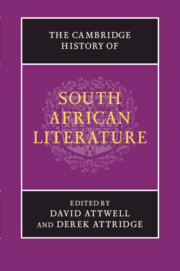Book contents
- Frontmatter
- Introduction
- PART I ORATURES, ORAL HISTORIES, ORIGINS
- PART II EXPLORATION, EARLY MODERNITY AND ENLIGHTENMENT AT THE CAPE, 1488–1820
- 6 Shades of Adamastor: the legacy of The Lusiads
- 7 In the archive: records of the Dutch settlement and the contemporary novel
- 8 Eighteenth-century natural history, travel writing and South African literary historiography
- PART III EMPIRE, RESISTANCE AND NATIONAL BEGINNINGS, 1820–1910
- PART IV MODERNISM AND TRANSNATIONAL CULTURE, 1910–1948
- PART V APARTHEID AND ITS AFTERMATH, 1948 TO THE PRESENT
- PART VI SOUTH AFRICAN LITERATURE: CONTINUITIES AND CONTRASTS
- Index
- References
6 - Shades of Adamastor: the legacy of The Lusiads
from PART II - EXPLORATION, EARLY MODERNITY AND ENLIGHTENMENT AT THE CAPE, 1488–1820
Published online by Cambridge University Press: 28 January 2012
- Frontmatter
- Introduction
- PART I ORATURES, ORAL HISTORIES, ORIGINS
- PART II EXPLORATION, EARLY MODERNITY AND ENLIGHTENMENT AT THE CAPE, 1488–1820
- 6 Shades of Adamastor: the legacy of The Lusiads
- 7 In the archive: records of the Dutch settlement and the contemporary novel
- 8 Eighteenth-century natural history, travel writing and South African literary historiography
- PART III EMPIRE, RESISTANCE AND NATIONAL BEGINNINGS, 1820–1910
- PART IV MODERNISM AND TRANSNATIONAL CULTURE, 1910–1948
- PART V APARTHEID AND ITS AFTERMATH, 1948 TO THE PRESENT
- PART VI SOUTH AFRICAN LITERATURE: CONTINUITIES AND CONTRASTS
- Index
- References
Summary
From a European perspective southern Africa was invented before it was discovered. As the giant spectre of Adamastor declaims to Vasco da Gama in William Atkinson's 1952 translation of Luis Vaz de Camões's Lusiads: ‘I am that mighty hidden cape, called by you Portuguese the Cape of Storms, that neither Ptolemy, Pomponius, Strabo, Pliny nor any other of past times ever had knowledge of’ (v, 50). Yet almost two thousand years earlier in the Meteorologica Aristotle had speculated that the northern temperate world of the Mediterranean had to be matched by a similar region south of the ‘uninhabitable’ equatorial wilderness of Africa. That this domain and its inhabitants might be the opposite, in every sense of the word, of the known ancient oecumene remained a subject of speculation throughout the Christian Middle Ages and beyond until Dias and da Gama at last stood face to face with the Khoikhoi.
By then a virtual consensus had been reached in patristic discourse that these southerners, whowalk ‘with feet opposite to ours’ (hence Antipodeans)would be anti- or pseudo-human caricatures of northern humanity. The baneful effect that such thinking would have on the earliest European encounters with sub- Saharan Africans and notably with the Khoikhoi cannot be pursued here (see Van Wyk Smith, ‘“Most wretched of the human race”’), but the conceit of a southern anti-human world, intrinsically hostile to Mediterranean civilisation and its harbingers, is fundamental to the trope of Adamastor as deployed by Camões and as variously echoed, refurbished or contested in the work of numerous southern African writers of the twentieth century.
- Type
- Chapter
- Information
- The Cambridge History of South African Literature , pp. 113 - 137Publisher: Cambridge University PressPrint publication year: 2012

